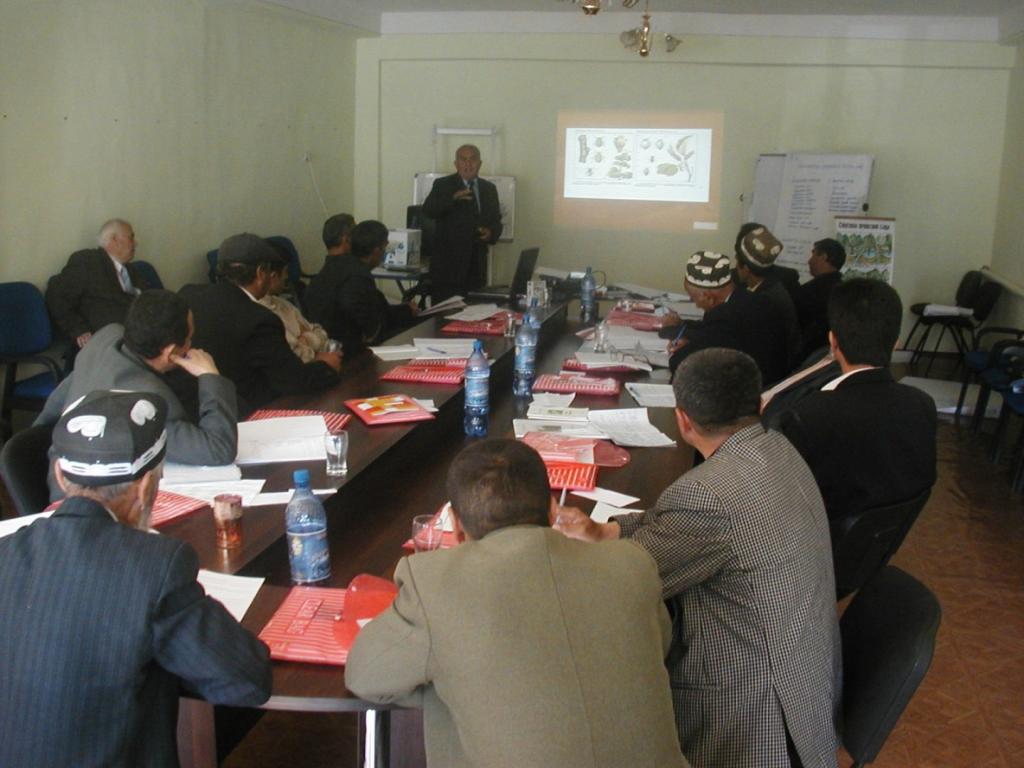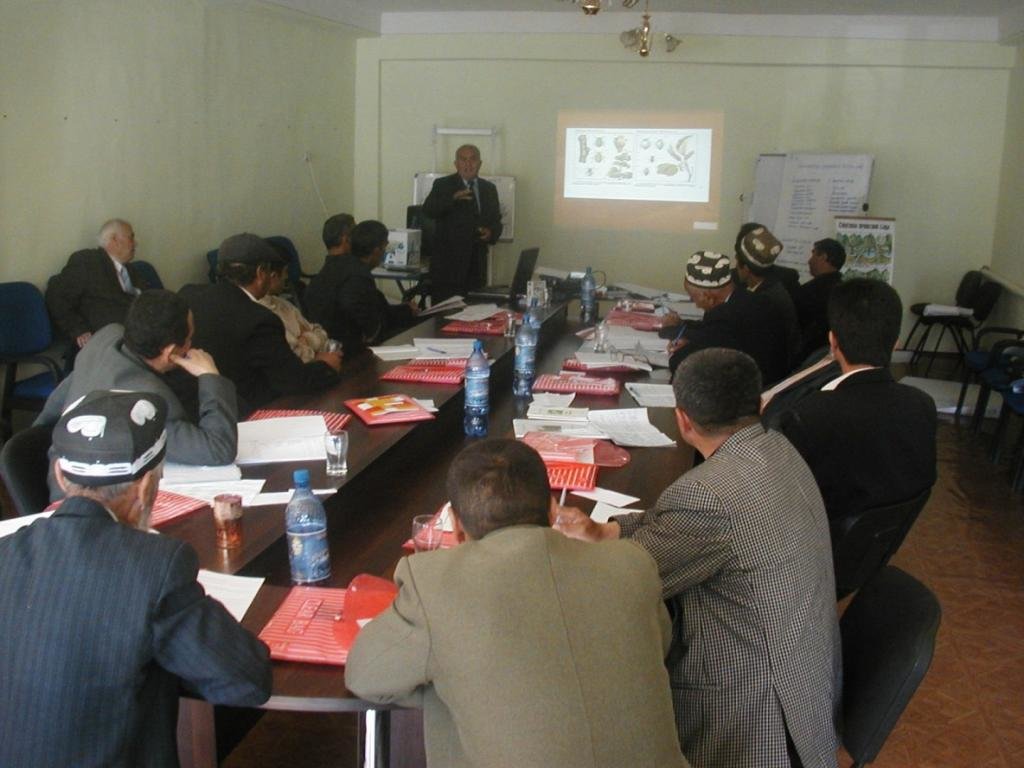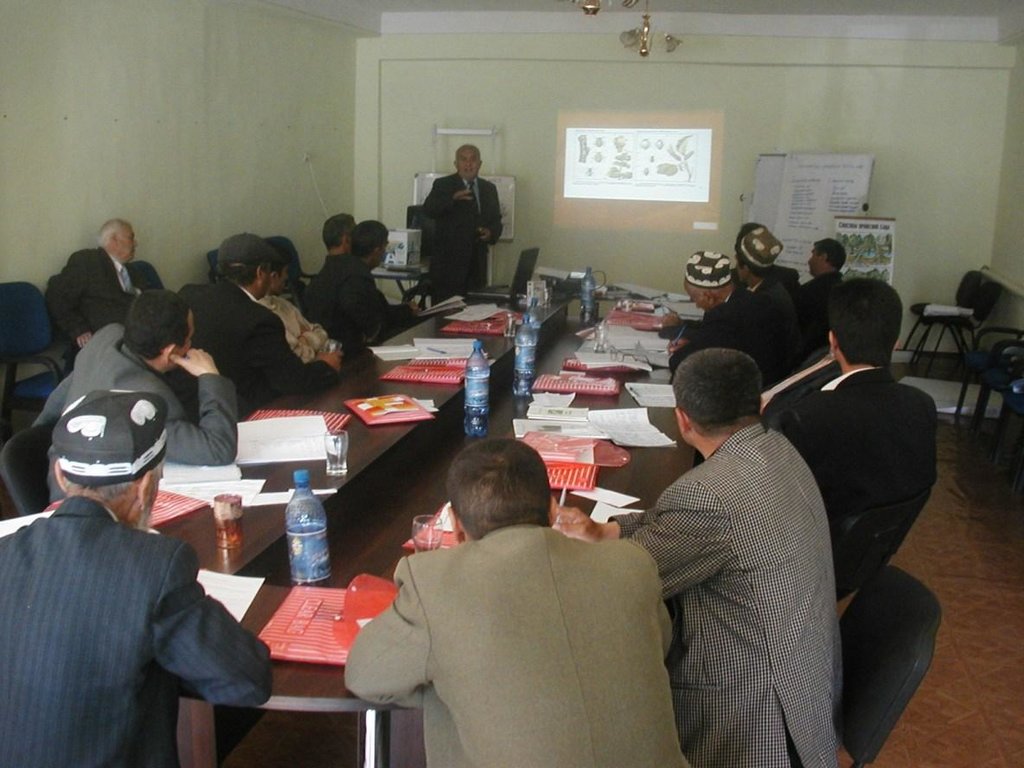Facilitation of community-based pasture management initiatives [塔吉克斯坦]
- 创建:
- 更新:
- 编制者: Mizrob Amirbekov
- 编辑者: –
- 审查者: David Streiff
Mountain Societies Development Support Programme - Aga Khan Foundation
approaches_2444 - 塔吉克斯坦
查看章节
全部展开 全部收起1. 一般信息
1.2 参与方法评估和文件编制的资源人员和机构的联系方式
SLM专业人员:
Pachova Nevelina
Palm
有助于对方法进行记录/评估的项目名称(如相关)
Sustainable Land Management in the High Pamir and Pamir-Alai Mountains (PALM Project / NCCR)有助于对方法进行记录/评估的机构名称(如相关)
Kyrgyzstan Mountain Societies Development Support Programme, Aga Khan Development Network (MSDSP KG) - 吉尔吉斯斯坦1.3 关于使用通过WOCAT记录的数据的条件
编制者和关键资源人员接受有关使用通过WOCAT记录数据的条件。:
是
2. SLM方法的描述
2.1 该方法的简要说明
Initiation of community-based solutions to slow down pasture degradation, and to improve pasture use and management in three pilot Jamoats of upland Tajikistan.
2.2 该方法的详细说明
该方法的详细说明:
Aims / objectives: During the Soviet times land users in Tajikistan were allowed to keep very little livestock individually and this was mainly in the vicinity of rural settlements. The majority of the livestock were managed by collective agricultural farms, which utilised different seasonal pastures. After the collapse of the Soviet Union, the previously state-owned livestock was distributed among individual farmers, most of whom had limited knowledge and experience with pasture management (PM), and capacities to access the distant pastures used by the collective farms. As a consequence, the amount of livestock kept in the vicinity of rural settlements increased, leading to overgrazing and severe degradation of nearby pastures. In the framework of a project on sustainable land management in the Pamir-Alai region (PALM), funded by the Global Environment Facility (GEF), MSDSP facilitated the initiation of community-based solutions to the problem of pasture degradation at three pilot jamoats in Jirgital, and three in Gorno-Badakhshan Autonomous Oblast (GBAO).
Methods: 1. Awareness raising and capacity building of PM issues. 2. Integration of PM issues in village development plans. 3. Grant support and community co-financing for implementation of targeted measures. 4. Monitoring of the impacts of the implemented measures as a basis for up-scaling.
Stages of implementation: 1. National pasture management experts from the Pamir Biological Institute held a training of trainers (ToT) session for MSDSP facilitators and district specialists, who conducted follow-up training on PM at the pilot communities in 2009. 2. Pilot communities identified key problems related to PM in the process of Village Development Planning facilitated by MSDSP, and prioritised targeted measures for improved PM. 3. A set of micro-project proposals were developed based on the prioritised measures, which focused on (re-) construction of roads and bridges for improved access to pastures, and construction of stables during spring/autumn, as well as summer pastures. 4. Monitoring of the impacts of the implemented measures as a basis for up-scaling.
Role of stakeholders: Community members were engaged in identifying and implementing targeted measures for addressing pasture use and management issues. Jamoat level non-governmental organisations called Social Unions for Development of Village Organizations (SUDVOs), coordinated and supported the identification and implementation of the selected projects in several village organisations. Governmental agricultural extension agents were engaged in training, and consulted in the review process. MSDSP staff facilitated the overall process and engaged in monitoring progress with implementation. PALM project staff engaged in the review, monitoring and assessment of the impacts of the supported measures.
2.3 该方法的照片
2.5 采用该方法的国家/地区/地点
国家:
塔吉克斯坦
有关地点的进一步说明:
Jirgatol
注释:
Three pilot jamoats in the Jirgital region (Jirgital, Pildon and Yangishar), and three in Gorno-Badakhshan Autonomous Oblast (GBAO), (Shitharv, Vankala and Alichur) were covered by the approach
Map
×2.6 该方法的开始和终止日期
注明开始年份:
2009
2.7 方法的类型
- 基于项目/方案
2.8 该方法的主要目的/目标
The Approach focused mainly on SLM with other activities (rehabilitation of rural infrastructure to improve access to pastures, pasture and livestock productivity, animal diseases)
The main aim of the approach was to initiate the improved use and management of pastures, by raising awareness and knowledge on issues regarding pasture degradation and sustainable pasture management, mobilising community action, and pilot-testing selected technologies and measures for improving pasture management in highly degraded areas.
The SLM Approach addressed the following problems: pasture degradation, overgrazing, restricted pasture area and too many cattle garzing, lack of infrastructure (bridges, roads, shelters), lack of knowledge about pasture management
2.9 推动或妨碍实施本办法所适用的技术的条件
财务资源和服务的可用性/可得性
- 阻碍
communities were lacking funds for infrastructure development and could therefore not invest in the construction of roads and bridges
Treatment through the SLM Approach: GEF funds were used to support communities in financing infrastructural improvements which allowed for more productive and sustainable use of available pasture resources
机构设置
- 阻碍
Lack of capacity to deal with pasture degradation problems
Treatment through the SLM Approach: Engagement of village organisations, and social unions of village organisations (SUDVO) in addressing pasture management issues at six pilot jamoats
法律框架(土地使用权、土地和水使用权)
- 阻碍
Limited clarity regarding responsibilities and lack of incentives for sustainable pasture management
Treatment through the SLM Approach: MSDSP and PALM project members recommended the development of a pasture management law that addresses those legal constrains
The existing land ownership, land use rights / water rights moderately hindered the approach implementation there is no law about pasture management in Tajikistan, therefore it was difficult to regulate the process
了解SLM,获得技术支持
- 阻碍
technical knowledge about pasture management was lacking as during Soviet times people were not allowed to keep a lot of livestock
Treatment through the SLM Approach: Community members of village organisations and relevant government experts were trained in various issues of pasture management
3. 相关利益相关者的参与和角色
3.1 该方法涉及的利益相关者及其职责
- 当地土地使用者/当地社区
Village organisations
Only 20% of the participants were women, since men are responsible for managing the livestock, while women are concerned with livestock products only
Elderly members of the communities were engaged in discussions on the possible solutions
- SLM专家/农业顾问
Governmental agricultural advisors participated in the training.
- 国家政府(规划者、决策者)
Agrarian University in Jirgatol, Pamir Biological Institute
- pilot communities
3.2 当地土地使用者/当地社区参与该方法的不同阶段
| 当地土地使用者/当地社区的参与 | 指定参与人员并描述活动 | |
|---|---|---|
| 启动/动机 | 无 | |
| 计划 | 互动 | Members of village organisations were involved in training and planning on pasture management, and actively participated in discussions |
| 实施 | 自我动员 | The village organisations developed their own project ideas and submitted those proposals to MSDSP and other funders |
| 监测/评估 | 互动 | Land users were engaged in the monitoring and evaluation of the impacts of the implemented projects |
| Research | 互动 | The Pamir-Biological Institute and the Institute of Botany under the Academy of Sciences were engaged in research and technical consultations |
3.4 有关SLM技术选择的决策
是否就技术的选择做出了决定?:
- pilot communities
解释:
Community members were engaged in identifying and implementing targeted measures for addressing pasture use and management issues.
Decisions on the method of implementing the SLM Technology were made by pilot communities and facilitators. Community members were engaged in identifying and implementing targeted measures for addressing pasture use and management issues.
4. 技术支持、能力建设和知识管理
4.1 能力建设/培训
是否为土地使用者/其他利益相关者提供培训?:
是
明确受训人员:
- 土地使用者
- 现场工作人员/顾问
培训形式:
- 课程
涵盖的主题:
Short training courses were provided for land user, field staff/agricultural advisors
4.2 咨询服务
土地使用者有权使用咨询服务吗?:
是
- through trained experts
说明/注释:
Name of method used for advisory service: Engineering support and technical consultations
Advisory service is quite adequate to ensure the continuation of land conservation activities
4.3 机构强化(组织发展)
是否通过这种方法建立或加强了机构?:
- 是,非常
具体说明机构的强化或建立程度:
- 本地
具体说明支持类型:
- 能力建设/培训
提供进一步细节:
village organisations were trained
4.4 监测和评估
监测和评估是该方法的一部分吗?:
是
注释:
economic / production aspects were regular monitored by project staff through observations; indicators: changes in economic benefits for households before and after implementation of project
bio-physical aspects were regular monitored by project staff through observations; indicators: changes in vegetation coverage, edible grass species, etc.
area treated aspects were regular monitored by project staff through observations; indicators: Established at the start of project implementation
There were several changes in the Approach as a result of monitoring and evaluation: Some areas were grazed although they should not have been, project staff then talked to the responsible people in the village to ask about the causes for this and to try and initiate changes in practice.
4.5 研究
研究是该方法的一部分吗?
是
- pasture management
提供进一步的细节,并指出是谁做的研究:
Aimed at problem, option and impact assessment
Research was carried out on-farm
5. 融资和外部物质支持
5.1 该方法中SLM组成部分的年度预算
如果不知道准确的年度预算,请给出一个范围:
- 2,000-10,000
注释(例如主要的资助来源/主要捐助者):
Approach costs were met by the following donors: international (PALM): 70.0%; national non-government (MSDSP): 30.0%
5.2 为土地使用者提供财政/物质支援
土地使用者是否获得实施该技术的财政/物质支持?:
否
5.3 对特定投入的补贴(包括劳动力)
- 基建
| 具体说明哪些投入得到了补贴 | 程度如何 | 对补贴做出具体说明 |
|---|---|---|
| 道路 | 部分融资 | |
| bridges, shelters | 部分融资 | |
如果土地使用者的劳动力是一项重要的投入,那么是不是:
- 自愿
5.4 信用
是否根据SLM活动的方法给予信用值?:
否
6. 影响分析和结论性陈述
6.1 方法的影响
该方法是否帮助土地使用者实施和维护SLM技术?:
- 否
- 是,很少
- 是,中等
- 是,支持力度很大
Reduced pressures on pastures in the vicinity of rural settlements
该方法是否有助于社会和经济弱势群体?:
- 否
- 是,很少
- 是,中等
- 是,支持力度很大
Elderly herders with improved access to health facilities
该方法是否改善了阻碍SLM技术实施的土地使用权/用户权问题?:
- 否
- 是,很少
- 是,中等
- 是,支持力度很大
talks with the government were started to make way for a law on pasture management
Did other land users / projects adopt the Approach?
- 否
- 是,很少
- 是,中等
- 是,支持力度很大
Strong interest by other communities but limited financial means for replication
Did the Approach lead to improved livelihoods / human well-being?
- 否
- 是,很少
- 是,中等
- 是,支持力度很大
Improved access to fodder, reduced loss of livestock, etc
Did the Approach help to alleviate poverty?
- 否
- 是,很少
- 是,中等
- 是,支持力度很大
The primary beneficiaries are the groups with a medium income
6.2 土地使用者实施SLM的主要动机
- 增加生产
Increased pasture area and livestock productivity, reduced loss of livestock, reduced labour inputs
- 环境意识
Increased awareness of the degradation of pastures
- well-being and livelihoods improvement
Improved convenience, reduced conflicts over livestock tramping and grazing of croplands
6.3 方法活动的可持续性
土地使用者能否维持通过该方法实施的措施(无外部支持的情况下)?:
- 是
若是,请说明如何维持:
The village organisations have the responsibility to teach their community members
6.4 该方法的长处/优点
| 编制者或其他关键资源人员认为的长处/优势/机会 |
|---|
| Reduction of conflicts over resource use and strengthened social capital (How to sustain/ enhance this strength: utilise the improved social capital for addressing other pressing environmental and community development issues) |
| Improved income from livestock provides a strong incentive for sustaining the established infrastructure (How to sustain/ enhance this strength: a proportion of the obtained income should be reinvested in maintenance e.g. through collection of user fees ) |
| Improved environmental conditions in the vicinity of rural settlements, and reduced labour inputs into livestock breeding (How to sustain/ enhance this strength: capitalise on those environmental improvements through the development of alternative income-generating activities such as bee-keeping and eco-tourism that will limit the need for further increases in livestock numbers) |
6.5 该方法的弱点/缺点以及克服它们的方法
| 编制者或其他关键资源人员认为的弱点/缺点/风险 | 如何克服它们? |
|---|---|
| Improved access to new pastures and possible further increases in livestock numbers may lead to their degradation in the future | Community members and village organisations have to make sure that the new pastures are being used in a sustainable manner e.g. through controlled grazing and pasture rotation, designation of no-grazing areas in pristine forests in the vicinity of new pastures, etc. |
| The approach contributes to improve the well-being of the medium income groups of the communities in question, as accessing distant pastures is most often not a problem for the better-off, while the poor often have only limited or no livestock | use as part of the generated additional income in the community for support of poor households |
| The approach is economically beneficial but difficult to up-scale due to the high initial investment costs | identify appropriate mechanisms for stimulating replication through relevant legal and policy incentives or alternative financing |
7. 参考和链接
7.1 方法/信息来源
- 实地考察、实地调查
- 与土地使用者的访谈
链接和模块
全部展开 全部收起链接
无链接
模块
无模块





